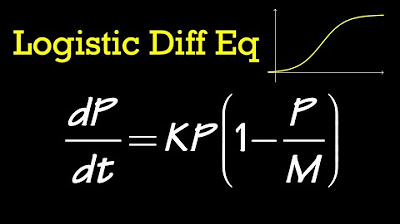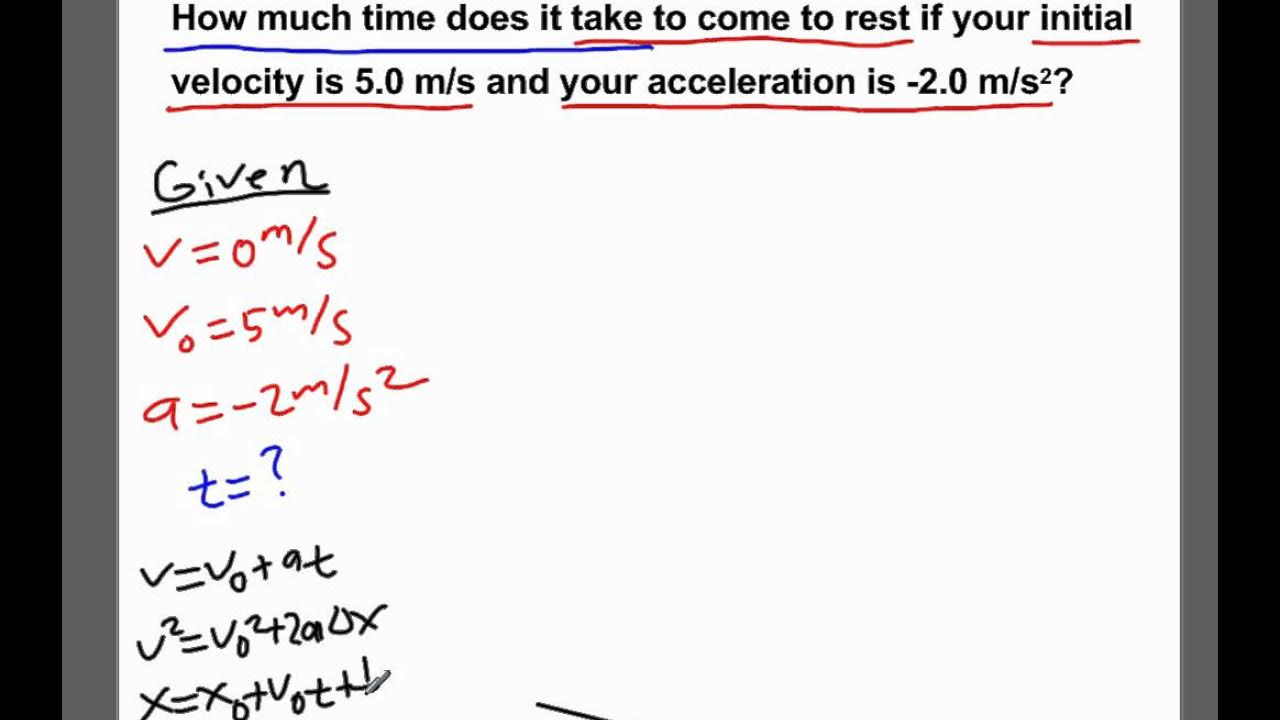2023 AP Calculus AB & BC FRQ #3
TLDRThe video script discusses a differential equation problem from the 2023 AP Calculus AB and BC exams. It involves a bottle of milk being warmed in a pan of hot water, with the function M(t) representing the milk's temperature in degrees Celsius over time in minutes. The problem's differential equation is M'(t) = 1/4 * (40 - M(t)), with the initial condition M(0) = 5°C. The video explains that M(t) will always be less than 40, indicating a horizontal asymptote at 40°C. It then uses the tangent line at t=0 to approximate the milk's temperature at t=2 minutes, finding an overestimation due to the function being concave down. Finally, the video solves the differential equation through separation of variables, applying the initial condition to find the particular solution M(t) = 40 - 35 * e^(-1/4 * t), which describes how the milk's temperature changes over time.
Takeaways
- 🧮 The problem involves a differential equation where the function M(t) models the temperature of milk in degrees Celsius at time t minutes after being placed in a pan of hot water.
- 🌡️ The differential equation given is dM/dt = 1/4 * (40 - M), which implies that M = 40 is a horizontal asymptote for the solution.
- ✍️ At t = 0, the initial condition is M(0) = 5°C, indicating the starting temperature of the milk.
- 📈 The slope field of the differential equation shows that the rate of change of M, dM/dt, decreases as M approaches 40°C.
- 🔍 To approximate M(2), the tangent line to the graph of M at t = 0 is used, with a slope of 35/4, leading to an approximation of M(2) = 5 + (35/4) * 2.
- 📉 The second derivative of M with respect to t, d²M/dt², is found to be negative, indicating that the function is concave down, which means the approximation of M(2) from the tangent line is an overestimate.
- 🔧 The solution to the differential equation is found by separation of variables, leading to an equation involving the natural logarithm and an integration constant C.
- 🔄 The integration constant C is determined using the initial condition M(0) = 5, which gives C = -35 after solving the equation.
- 🌟 The particular solution to the differential equation, with the determined value of C, is M(t) = 40 - 35 * e^(-1/4 * t).
- 📚 The video emphasizes the importance of not oversimplifying expressions to avoid mistakes, especially when dealing with differential equations.
- 🎯 The process of solving the differential equation, including finding the second derivative and using it to determine the nature of the approximation, is thoroughly explained in the video.
Q & A
What is the main topic of the video?
-The video is about solving a differential equation problem from the 2023 AP Calculus AB and BC exams, specifically involving the temperature of milk in a pan of hot water.
What is the differential equation that models the temperature of the milk?
-The differential equation is dM/dt = 1/4 * (40 - M), where M is the temperature of the milk in degrees Celsius and t is the time in minutes.
What is the initial condition given for the temperature of the milk?
-The initial condition is that at t = 0 (time equals zero), the temperature of the milk (M) is 5 degrees Celsius.
What does the '40' in the differential equation signify?
-The '40' in the differential equation represents a horizontal asymptote, indicating that the temperature of the milk (M) will not exceed 40 degrees Celsius.
How is the slope field used in the problem?
-The slope field is used to visualize the behavior of the differential equation, helping to sketch the solution curve and understand the horizontal asymptote at 40 degrees Celsius.
What is the purpose of approximating M of 2 using the tangent line at T equals zero?
-The purpose is to estimate the temperature of the milk at 2 minutes using the initial slope of the solution curve, which is derived from the initial condition and the given differential equation.
How is the equation of the tangent line derived?
-The equation of the tangent line is derived using the slope of the solution curve at T = 0, which is 35/4, and the point (0, 5) representing the initial condition.
What does the second derivative of M with respect to T tell us about the function M(T)?
-The second derivative, when negative, indicates that the function M(T) is concave down, which means that the tangent line approximation at T = 0 is an overestimate of the actual temperature of the milk at T = 2.
How is the particular solution to the differential equation found?
-The particular solution is found by separating variables and integrating both sides of the differential equation, then applying the initial condition to solve for the constant of integration.
What is the final expression for M(T) after solving the differential equation?
-The final expression for M(T) is M = 40 - 35 * e^(-1/4 * T), which represents the temperature of the milk as a function of time.
Why is it important to consider the concavity of the function when approximating the temperature at T = 2?
-Considering the concavity is important because it helps determine whether the tangent line approximation is an overestimate or an underestimate of the actual value, which is crucial for the accuracy of the approximation.
What is the significance of the initial condition in solving differential equations?
-The initial condition provides a specific point on the solution curve, which is essential for determining the constant of integration and finding the particular solution that satisfies both the differential equation and the given condition.
Outlines
🧊 Differential Equation Problem: Warming Milk
The video begins by addressing a differential equation problem from the 2023 AP Calculus AB and BC exams. The problem involves a bottle of milk being warmed in a pan of hot water, with the function M(t) representing the milk's temperature in degrees Celsius at time t in minutes. The differential equation is dM/dt = 1/4 * (40 - M), and it's noted that M(t) will always be less than 40, indicating a horizontal asymptote at 40 degrees. The video provides a sketch of the solution curve, respecting the asymptote, and then moves on to approximate the temperature of the milk at T=2 minutes using the tangent line method. The tangent line's equation is derived from the differential equation at T=0, where M=5 degrees. The approximation yields M(2) ≈ 5 + (35/4)*2. The video concludes this section by discussing the second derivative to determine if the approximation is an over or underestimate, finding that since M(t) < 40 for all t, the function is concave down, leading to an overestimation by the tangent line method.
📚 Separation of Variables to Solve the Differential Equation
The second paragraph delves into solving the differential equation using the method of separation of variables. The given differential equation is rearranged by factoring out the negative sign, resulting in -dM/dt = 1/4 * (M - 40). The separation of variables technique is applied, moving all terms involving M to the left side and all terms involving t to the right side, yielding an integral equation. The integration leads to the natural logarithm for the M terms and a simple multiplication for the t terms, with an integration constant C. To find the particular solution that fits the initial condition M(0) = 5, the constant C is solved for, resulting in C = -35. The final solution for M(t) is expressed as M = 40 - 35 * e^(-1/4 * t), which is the temperature of the milk as a function of time. The video emphasizes the importance of careful integration and solving for the constant to accurately model the temperature change of the milk.
Mindmap
Keywords
💡Differential Equation
💡Increasing Function
💡Horizontal Asymptote
💡Slope Field
💡Tangent Line
💡Second Derivative
💡Concave Down
💡Separation of Variables
💡Natural Logarithm
💡Initial Condition
💡Exponentiation
Highlights
The video discusses a differential equation problem from the 2023 AP Calculus AB and BC exams.
A bottle of milk is warmed in a pan of hot water, and its temperature is modeled by an increasing function M(t).
The function M(t) satisfies the differential equation dM/dt = 1/4 * (40 - M).
At time t=0, the milk's temperature is given as 5 degrees Celsius.
The horizontal asymptote of any solution is at M = 40, as dM/dt will always equal zero if M is 40.
The slope field for the differential equation is shown, indicating the horizontal asymptote at 40 degrees Celsius.
The video demonstrates sketching the solution curve through the point (0, 5), respecting the horizontal asymptote.
An approximation for M(2) is derived using the tangent line to the graph of M at t=0.
The tangent line equation is y - 5 = (35/4) * (t - 0), used to approximate the milk's temperature at t=2 minutes.
The second derivative of M(t) is expressed in terms of M to determine if the approximation for M(2) is an over or underestimate.
Since M(t) is less than 40 for all t, the second derivative is negative, indicating the function is concave down.
The tangent line approximation for M(2) is identified as an overestimate due to the concavity of the function.
The method of separation of variables is applied to find the particular solution to the differential equation.
The differential equation is rearranged by factoring out the negative coefficient on M.
Integration leads to an expression involving the natural logarithm and an exponential function to solve for C.
The constant C is determined by using the initial condition M(0) = 5, resulting in C = -35.
The final expression for M(t) is derived as M = 40 - 35 * e^(-1/4 * t), completing the solution to the problem.
The video concludes by summarizing the solution process and wishing viewers good luck.
Transcripts
5.0 / 5 (0 votes)
Thanks for rating:





